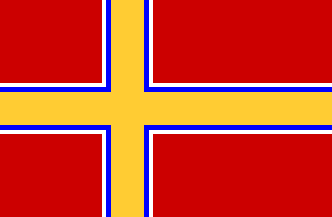 image by Ossi Raivio, 20 October 1998
image by Ossi Raivio, 20 October 1998Proportions 17:26 = (6.5 + cross + 6.5):(8 + cross + 15), where cross = 0.35 + 0.4 + 2.5 + 0.4 + 0.35.

Last modified: 2014-10-04 by zoltán horváth
Keywords: finland: historical flags (1918-1920) | scandinavian cross | lion: with sword (yellow) | crown | mannerheim (gustaf) |
Links: FOTW homepage |
search |
disclaimer and copyright |
write us |
mirrors
See also:
 image by Ossi Raivio, 20 October 1998
image by Ossi Raivio, 20 October 1998
Proportions 17:26 = (6.5 + cross + 6.5):(8 + cross + 15), where cross = 0.35 + 0.4
+ 2.5 + 0.4 + 0.35.
![]()
Red flag with golden yellow cross bordered blue and white.
Adopted 1998-02-27. Abolished 1918-05-29.
This is the first official Finnish national flag. It was adopted as merchant
ensign, but that word (in Finnish) means national flag, too. The law was never passed
because of the Civil War, but Senate gave order to use this flag as temporary merchant
ensign.
Ossi Raivio, 20 October 1998
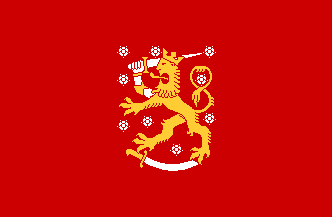 image by Ossi Raivio, 20 October 1998
image by Ossi Raivio, 20 October 1998
Proportions 17:26
![]() .
.
Adopted 1918-02-27. Abolished 1918-05-29.
Red flag with the Finnish lion in golden yellow and white.
This is the first official Finnish state flag. The Senate's proposal was made 1917-12-21 and this flag was hoisted 1917-12-28 on a Finnish ice-breaker, but again - the law was never passed because of the Civil War, but the Senate gave order to use this flag as temporary state flag.
After the Civil War between the Whites (government's forces) and the Reds (socialist
rebels) was ended in the victory of the Whites, the red colour wasn't popular at
all. So, the Parliament passed a law about the Finnish flag - the blue cross on
white.
Ossi Raivio, 20 October 1998
 image by Ossi Raivio
image by Ossi Raivio
Proportions 11:18 = (4+3+4) : (5+3+10)
![]() .
.
Adopted: 1918-05-29
Abolished 1920-02-12
Editorial Note: The shade of blue differs from that of the current flag, although the proportions and other graphical information is the same
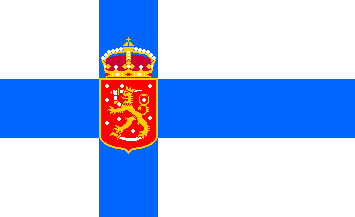 image by Ossi Raivio, 20 October 1998
image by Ossi Raivio, 20 October 1998
Proportions: 11:18 = (4+3+4):(5+3+10)
![]() .
.
Adopted: 29 May 1918, Abolished: 12 February 1920
White flag with blue cross and the Finnish coat of arms in the middle of the cross - crowned with a grand duke's crown. The shade of the blue colour is "ultramarine (sea) blue", whatever that is supposed to mean. I have used a browser safe palette colour which is quite near the original one.
Ossi Raivio, 20 October 1998
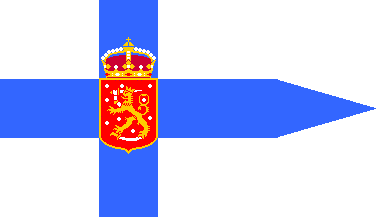 image by Ossi Raivio
image by Ossi Raivio
Proportions: 11:19 = (4+3+4):(5+3+5+6)
![]()
Adopted: 29 May 1918, Abolished: 12 February 1920
Finland doesn't have a set of diplomatic flags any more, but we've had one. These flags were adopted on 18 June 1919, but it is not clear if they were ever used before they were abolished in 1920.
 image by Ossi Raivio, 29 August 2001
image by Ossi Raivio, 29 August 2001
Ambassador and Minister Plenipotentiary: Variation of Finnish national flag (ie. plain blue Scandinavian cross on white). Upper hoist field was not white but it had a yellow cross on red with the Finnish coat of arms in the middle of the yellow cross.
The source shows a very thin fimbriation between the red canton and the blue cross. However, the source is black-and-white so it is impossible to tell whether this fimbriation is yellow or white. I used yellow to match the colour of the cross in the canton.
Source:
· Laurla, Kari K.: Suomalainen päällikkyysmerkki, Collegium Heraldicum Fennicum,
Vantaa 1986. Printed in Helsinki by Painonikkarit.
Ossi Raivio, 22 January 1999 and 29 August 2001
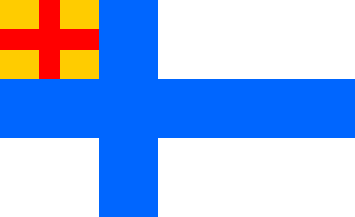 image by Ossi Raivio, 29 August 2001
image by Ossi Raivio, 29 August 2001
Charge d'Affairs: Finnish national flag with a red cross on yellow in the upper hoist field.
Source:
· Laurla, Kari K.: Suomalainen päällikkyysmerkki, Collegium Heraldicum Fennicum,
Vantaa 1986. Printed in Helsinki by Painonikkarit.
Ossi Raivio, 22 January 1999
 image by Ossi Raivio, 29 August 2001
image by Ossi Raivio, 29 August 2001
Consul General: Finnish national flag with two blue crossed anchors in the upper hoist corner.
Source:
· Laurla, Kari K.: Suomalainen päällikkyysmerkki, Collegium Heraldicum Fennicum,
Vantaa 1986. Printed in Helsinki by Painonikkarit.
Ossi Raivio, 22 January 1999
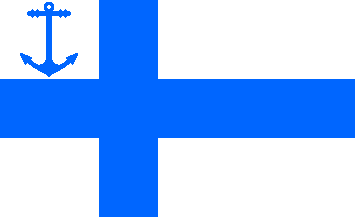 image by Ossi Raivio, 29 August 2001
image by Ossi Raivio, 29 August 2001
Consul and Vice Consul: Finnish national flag with one blue anchor in the upper hoist corner.
Source:
· Laurla, Kari K.: Suomalainen päällikkyysmerkki, Collegium Heraldicum Fennicum,
Vantaa 1986. Printed in Helsinki by Painonikkarit.
Ossi Raivio, 22 January 1999
21 March 1917 the Finnish constitution is re-established by the Russian Provisional government. 8 December 1917 Finland is independent de facto and was recognized by Russian Bolchevik government 9 January 1918. But, after some days the Finnish Bolcheviks take the power in Helsinki and proclaim the Soviet Republic. The white forces of the government (leadership by Mannerheim) with the help of the German expeditionary corp, regain the power in Helsinki (12 April 1918) and win the bolcheviks forces in Häme (4 May 1918).
After this the parliament proclaimed the Kingdom of Finland (9 October
1918) with Frederic Charles of Hessen as king, but [he did] not accept. The republican
form was established in June 1919.
Jaume Ollé 27 May 1997
Well, at first this brother-in-law of the German emperor did accept, but redrew when the "Kaiser" was forced to resign.
(Source: Aanval op Finland by Drs. Paul Luykx et.al. in "Bericht van
de Tweede Wereldoorlog").
Mark Sensen 29 May 1997
This flag is presented at
http://varpho.deviantart.com/gallery/#/d2dqd0r
Was this ever a real proposal or is it a modern imagination of what might have
been? There is not much information on that page.
Elias Granqvist, 23 August 2010
No, this flag for "Red Finland', and the other, for the putative 'Upper
Silesian Soviet Republic' of 1920 are just musing of the Polish graphic artist,
Szymon Pawlak (aliases: Varpho and DeviantArt) who confesses acute interest in
vexillology.
The Finnish flag contains in the canton the ornaments from the Coat of Arms and
the sicle and axe appearing at the monument to Tsar Alexander II in the center
of Helsinki. The Upper Silesian communist flag contains the Teschen Silesia
heraldic devices.
It's just a bunch of quite interesting and imaginative projects, including two
or three proposals for the Polish Lutheran flag and a splendid (IMVHO) HaTikvah
(Hope) flag.
Chrystian Kretowicz, 23 August 2010

image by
António Martins-Tuválkin, 27 August 2010
At <
http://www.tsl.state.tx.us/exhibits/suffrage/victory/flags.jpg
>,
a pamphlet published by the National Women Suffrage Publishing Co., NY,
U.S., shows 13 flags under which women vote, surrounding a
48-star
flag of the U.S., under which they did not. That dates
this item to 1912-1920.
The flags are mostly unsurprising (clockwise from 3 o'clock):
- Iceland (no image in FotW-ws?)
- Sweden
- Ireland (but green with centered harp maid between
crossed fronds and 'Erin go Bragh', all yellow)
- Scotland (but lion passant the hoist; crossed with the
next)
- Wales (but with green and white edging, round forked
fly, like this one, although not tapering)
- England (red ensign)
- Canada (but no crown, yes garland, app. quartered shield, these pages need editing)
- Australia (red ensign)
- New Zealand (red ensign)
- Denmark
- Russia (dating this pamphlet as previous to 1917)
- Norway (but with 'couped' blue cross, not touching the edges)
- Finland (blue and white horizontal bicolor)
This design is not unlike some of the proposals for a Finnish flag at the time,
namely the 1863 Helsingfors Tidningar's
proposal #3 and Zecharias Topelius'
original proposal.
António Martins-Tuválkin, 27 August 2010